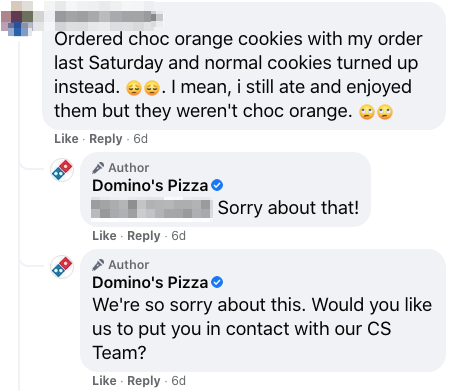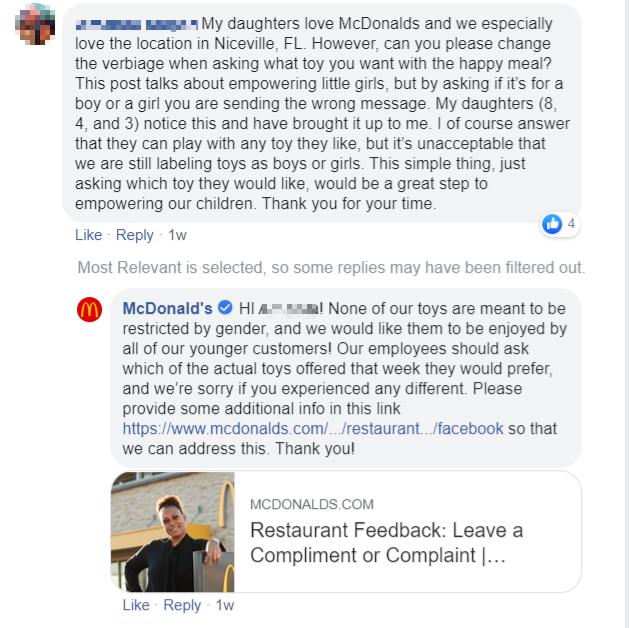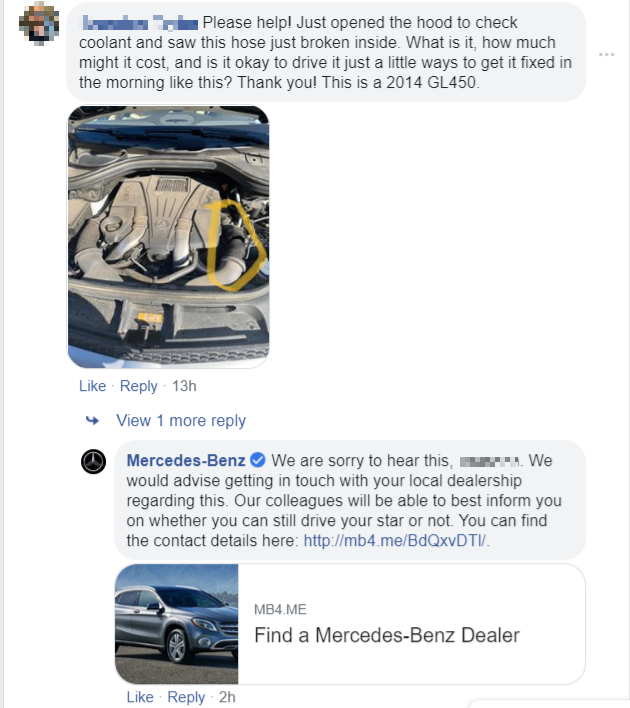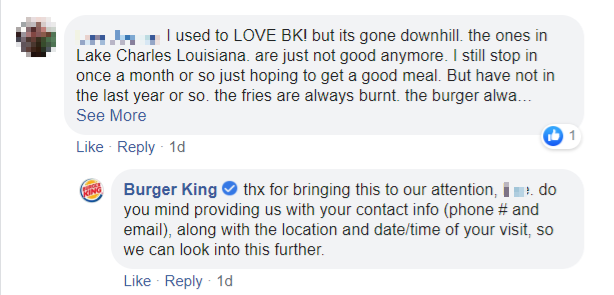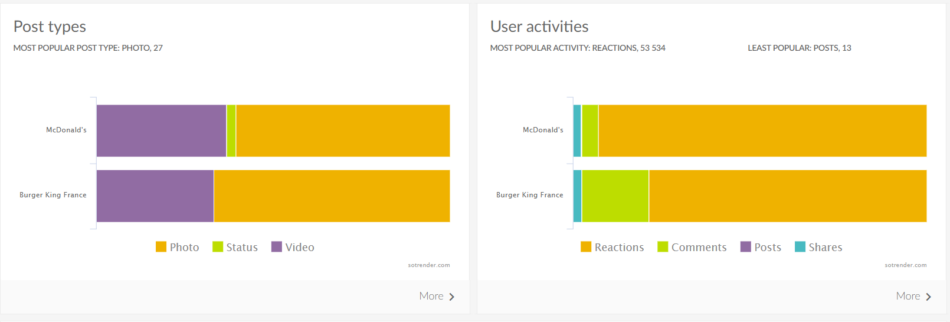Businesses on social media recognize the importance of making sure their customers are satisfied. Your brand’s representation on social media can determine whether or not you will have a loyal follower base. That’s where Facebook social customer service comes into the picture.
Facebook Social Customer Service: a quick intro
First of all, it’s not just about content moderation on Facebook. Social customer service means that you are:
- Managing your brand’s community
- Curating content for your followers
- Moderating comments and what other users post
- Making sure everyone follows the guidelines of the community
- Answering any questions or concerns your audience has (either under a post, your ad or in Messenger)
- Engaging in group discussions
As you can see, it consists of several different responsibilities and it doesn’t only include simply deleting inappropriate comments. Successful social customer service means that your audience feels secure in openly communicating with your brand. As a result of that, your brand will build a community of fans that will be loyal and willing to keep coming back to your business.
Now that you’re caught up, let’s look at 15 practices you should follow to provide excellent social customer service!
1. Learn more about your audience
This means that you need to analyze their social data such as psychographics and demographics. Don’t be deceived by how complicated it sounds. To get this information, you can simply make use of your own internal data or information that you can easily find online, for example in your own customer service software, Google Analytics or Facebook Audience Insights. Find out whether you’re using the right channels to reach your target audience. It just might be the case that your audience likes to discuss in private Facebook groups, and not directly on your own Page. Inversely, they may like for things to be out in the open, so they’ll prefer talking directly to you in the comments section.
Knowing where your audience lives allows you to tackle a few different issues. For one, you’ll know if you should have multilingual moderators ready to respond to your clients in different languages. Second, you’ll know what times you should be posting on social media since they might miss the content otherwise.
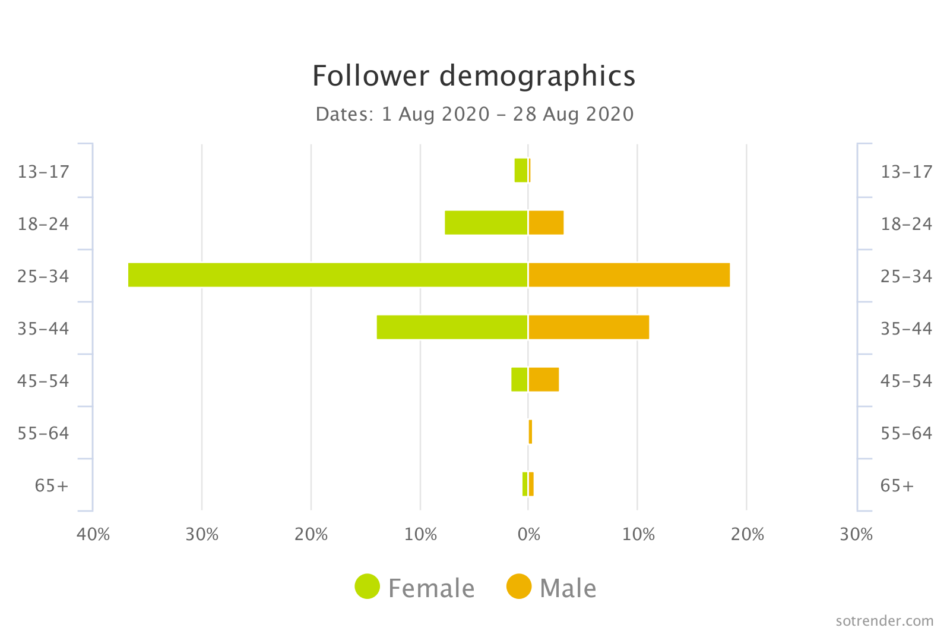
Audience demographics in Sotrender
Finally, knowing the psychographic profile of your audience helps you understand how you should talk to them. Are they teenagers or are they people who have some kind of a niche hobby? Whatever the case may be, each of these requires different attention than the other. The way your message gets across depends on how you phrase yourself to your audience.
2. Choose your tone (on a brand and individual level)
Once again, you need to know your audience to figure out how you should talk to them. You need to also make sure that moderators are consistent. Therefore, it’s a common practice among brands to create guidelines on the tone and style of their communication. It’s recommended to decide on these issues before you actually start communicating with the users and make sure that all members of the social media team follow the same rules.
You might consider using emojis, but make sure that they are appropriate for your audience.
3. Monitor how people feel about your brand
Although you should monitor the typical social media metrics such as engagement and reach, you should also keep an eye on social sentiment.
Sentiment analysis is a very important indicator of how your audience views your brand. Positive sentiment means that people generally have a positive association with your brand, which means they’ll likely become loyal fans. Being trustworthy, responsible, and helpful is good for your brand and your consumers.
One way of checking your sentiment online is to track comment sentiment on your social media profile.
4. Make it personal
People feel better if they know you’re recognizing them as an individual with their own needs and opinions. By addressing the person with their name and addressing their specific problem, you’re building rapport. These personalized interactions show your users that you are taking the time to consider what they said and you’re giving them the full attention they need.
To provide you with an example from our own playground, we always try to wrap up the comment in a personal way with the moderator’s name or the brand. We would usually end it with “- Ania from Sotrender” or “Best, Sotrender team”. In other words, don’t be a stranger and stay consistent!
5. Encourage the users to talk about their experience
It’s always a good idea to start conversations with your fans. You can ask your fans whether they’re willing to share their experiences with your brand. By doing so, other potential clients could see that you are trustworthy and reliable and they might want to open up and comment more. This will increase engagement under your posts and thus contribute to the overall success of your Facebook page. Companies answering clients in an automated way won’t build this kind of rapport, as people wouldn’t be so interested in opening up about their experiences in a simplified chat with a bot.
A good strategy that we at Sotrender always follow is to ask your clients, whether they enjoy the products or services they purchased. Getting feedback from your fans means that you can use the knowledge to improve your product and services in a way that suits their needs better. You’ll make your fans feel appreciated by showing them that you are listening to them and taking notes.
6. Don’t overstep boundaries
Remember, breaking the ice doesn’t mean you should become too friendly. At the end of the day, you’re still representing the company. Specifically, you need to make sure your responses won’t be taken in the wrong way. That means you shouldn’t try to push too much humor or sarcasm, and avoid being too “edgy”. Remember that the written words, without the context of facial expression or the tone of voice, might be interpreted in a different way.
If a user is pushing your buttons, don’t be reactive and don’t insult anyone. It’s easy to get caught up in the heat of the moment, but you have to resist the urge. It looks unprofessional, and it creates a hostile environment where trust is lost.
7. Stay organized
Staying organized is crucial if you want to be efficient at social customer service. Having a group of moderators actively working on your brand’s social media networks requires sophisticated planning.
First thing’s first, distribute the responsibilities among the moderators. Every moderator has a topic that they’re particularly interested in or a niche they have experience with. For example, if you are a cosmetic company, one of your moderators might have knowledge about specific products such as skincare, another might have more insight into haircare. Assign each of your moderators to deal with a specific comment or problem your Facebook audience might have.
It’s also crucial that moderators know which user needs to be responded to. Remember to tag the conversations so that it’s clear to everyone who is dealing with which user, and which users require answers.
8. Keep track of other moderators
As always, quality control is a must for a business. You should always know which moderator said what to maintain accountability. If you see a moderator that stands out as a social customer service provider, it might be useful to have other moderators adapt to their style of responding.
On the other hand, you need to see if a moderator has been performing poorly and the fans they’ve talked to are unhappy with their interaction. If that’s the case, you need to make better decisions about who should represent the brand on social media.
9. Be prepared
It’s important that you have certain responses ready for a variety of situations. If you foresee a potential crisis, you need to know what to say in case of dissatisfied users. This could include informative answers about any potential issues such as environmental issues or regarding health and safety.
What’s more, if there are frequently asked questions, you should have prepared answers for those as well. The same goes for positive feedback and dissatisfied customers. Inconsistencies in moderator answers mean that there is a lack of agreement and your fans won’t know what answer is actually legit.
10. Private or public?
Once in a while, you might come across a user who has a very specific problem or concern and is rather nagging. Keeping the conversation going in the comment section might infringe on their privacy and irritate other commenting users, so you should ask them for permission to switch to direct messages. By doing so, you will give the user the personal care they need, and they will appreciate communicating with a brand that listens to them.
Consider a situation where a user might be frustrated and wants to let out some steam. Just empathize with your client, reassure them, and give them help to the best of your ability. If they are still upset, ask them to switch to direct messages instead. It’s never fun for other customers to witness a public meltdown in the comments section.
11. All in due time
It’s crucial that you respond to your fans at a reasonable pace. That doesn’t necessarily mean that you should nonchalantly dish out several responses within minutes. Some companies even include the desired moderator’s response time already in their community guidelines. If this time limit hasn’t been set openly by the brand, we recommend against leaving a comment unanswered for more than an hour.
The best thing you can do is take the time to consider what the person wrote and think of the best possible response. If it’s a common occurrence, it likely won’t take you a very long time to come up with the right thing to say. You don’t want one poorly constructed comment to make the person on the other end feel worse and also feel like the company isn’t doing its job well enough.
12. Post your Facebook page rules
Before anything, you need to make sure that the community guidelines of your page are clearly communicated. You should make sure that a non-vulgarism policy is there from the start. That means that if you see a user leaving comments that contain vulgarity, spreading hate speech, or other personal attacks, you need to delete the comment. In order to avoid the potential outrage of a user whose comment has just been deleted, you need to have something like a public Facebook Page Code that you can refer to. Therefore, we recommend posting your rules of communication, for example, at your Facebook Page in ‘Our Story’ section.
It’s important for your community to be a safe place for your followers and customers to express their opinions and problems. A hostile environment emerges if the content isn’t properly moderated. Once you see that someone has breached your policies with an unproductive comment or spam, feel free to delete the comment. Once you learn how to identify bots and trolls, it allows you to provide better care to loyal customers.
13. Monitor your competitors
There’s simply no way around it. You need to know how you can outshine the competition. Check how their social media profiles are doing. Are people commenting under their posts? Are they interacting with their fans or ignoring them? How long does it take them to reply to each person and comment? Are they personalizing their messages, and how is their customer base reacting to it?
You can always compare your own brand to a competitor by adding both Facebook pages to a “comparison group” in Sotrender. You’ll be able to compare and contrast the best content, top-performing posts, as well as the change in the number of fans over time. To beat your competitors on Facebook, you need to make competitive benchmarking social media performance a regular habit.
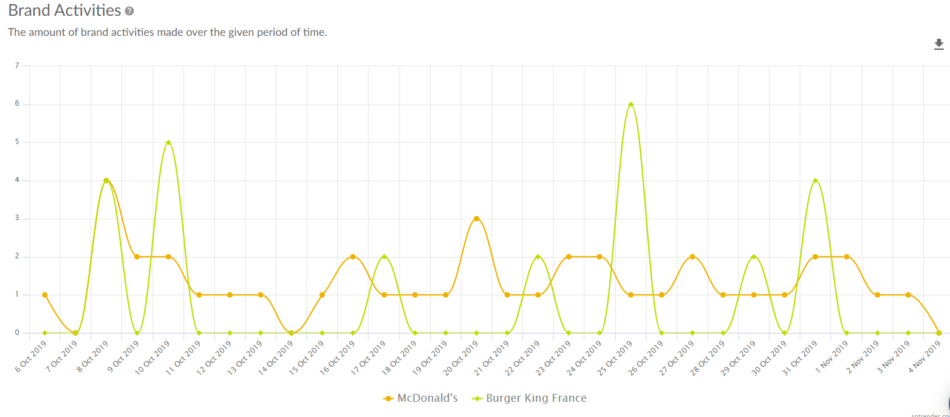
Comparison of brand activities over time in Sotrender
We’re not saying that you should copy the competition, instead, you need to learn vicariously and pick and choose what works for you. If your competitors are not at the top of their game in one domain, try to do better. Provide your target audience what’s missing in the current market, and they’ll definitely appreciate it.
14. Check your social media metrics
Now that you’ve done your research and started properly engaging with your followers, it’s time to see if you’re reaping any benefits. Your data will help you make better decisions about your efforts and what you should be doing going forward.
Using an analytics and social inbox tool like Sotrender’s, you can check how your profiles have fared at this time. Add your profile and take a look at the most important metrics. These can include but aren’t limited to:
- Follower growth (slightly before and after you’ve changed your social customer service strategy)
- Engagement (user activities and Interactivity Index)
- PTAT (people talking about this)
- Sentiment
Sentiment analysis is a very important indicator of how your audience views your brand. Positive sentiment means that people generally have a positive association with your brand, which means they’ll likely become loyal fans. Being trustworthy, responsible and helpful is good for your brand and your consumers.
A Facebook analytics tool will tell you everything you need to know. If your engagement rate is still not increasing, then it might be time to think not only about your content strategy, but also to adjust the way you provide social customer service on Facebook.
15. Measure your social inbox metrics
Just as you should measure your social media analytics, you should also know how the conversations took place. Specifically, you should look out for:
- When did you post the most comments (on a weekly and monthly basis) and consequently, when your users were the most active.
- How many people has your Facebook community management team responded to
- How many monthly conversations went on
- The time it took to answer and get involved in conversations
If, in spite of your efforts, your results still aren’t as good as expected, gathering the data and analysis will help you identify the problematic areas. Check your metrics regularly so you can make sure your strategy is working as intended.
So that was it!
Now you’re equipped with 15 practices to improve the quality of your social customer service. As long as you follow these tips, your Facebook moderation tasks should go smoothly.
Do you have any other tips that you can think of? You can always message us or leave a comment!

